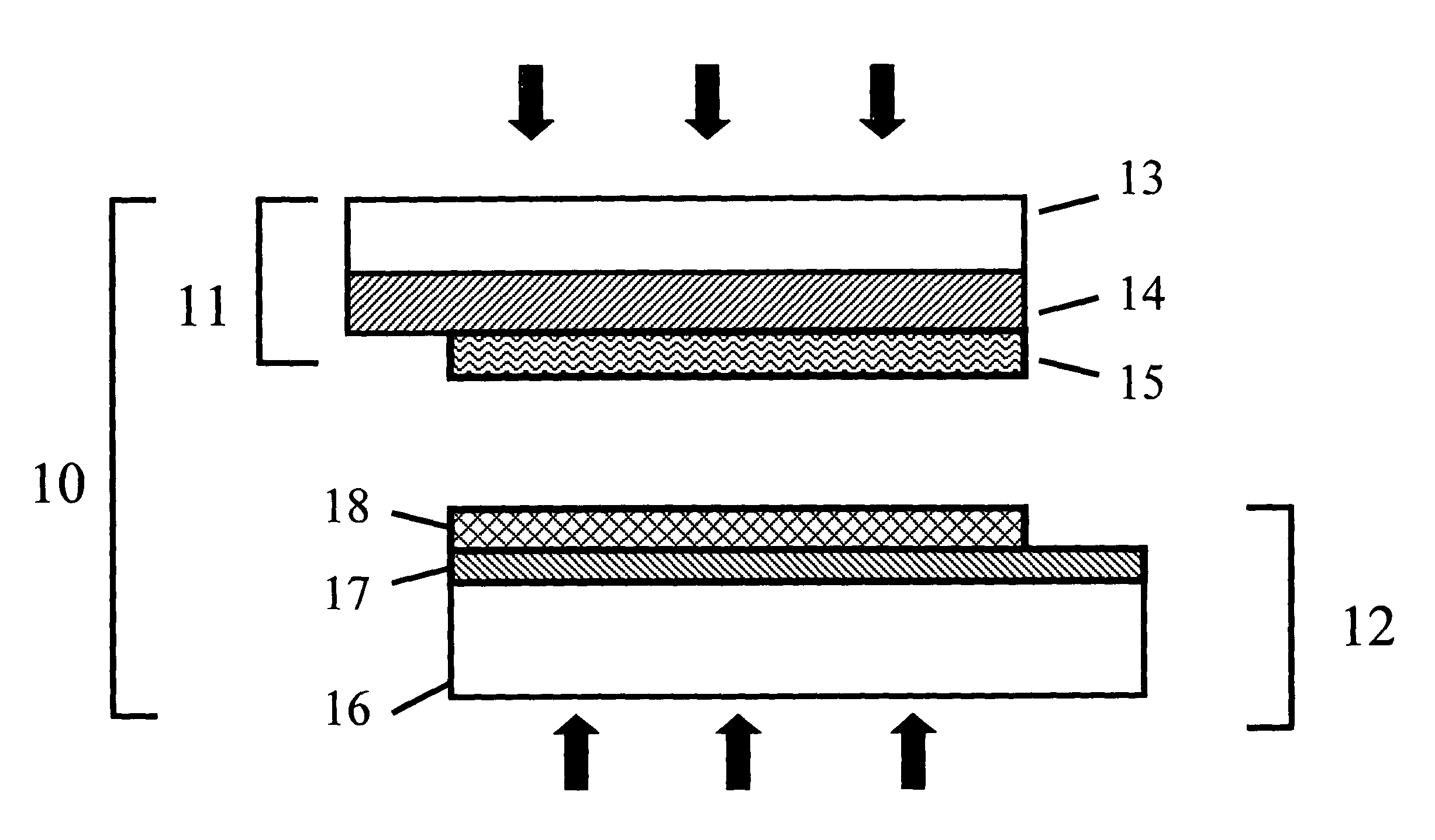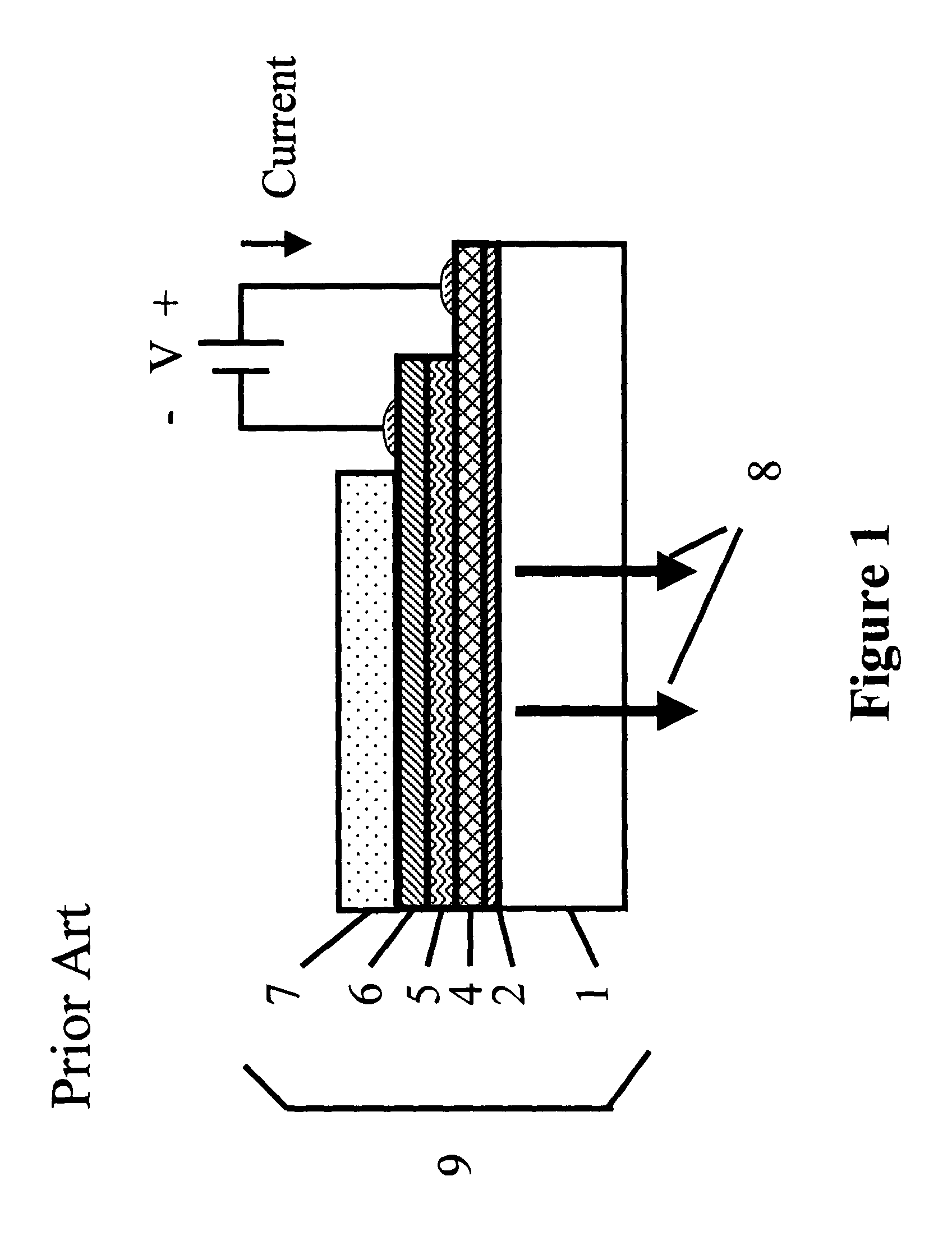Organic semiconductor devices and methods of fabrication including forming two parts with polymerisable groups and bonding the parts
a semiconductor device and organic material technology, applied in the direction of sustainable manufacturing/processing, nanoinformatics, final product manufacturing, etc., can solve the problems of inflexible sequential methods, compatibility of materials, and the choice of solvents still remains a problem, so as to achieve flexibility and versatility.
- Summary
- Abstract
- Description
- Claims
- Application Information
AI Technical Summary
Benefits of technology
Problems solved by technology
Method used
Image
Examples
example 1
The Formation of the First Part (11) with a Light-Emitting Polymer
[0027]A layer of nickel was first deposited onto a glass substrate by conventional coating methods. Then onto the top surface of nickel, a layer of semiconducting polymer MEH-PPV (structure shown in FIG. 6(a)) is spin-coated from a 1% wt. / v of MEH-PPV in toluene at 2000 rpm. A low temperature heat treatment of the sample with the semiconducting polymer is now carried out to vaporize the solvent trapped within the polymer and to improve the molecule arrangement within the film. The heat treatment may be carried out in an inert atmosphere at a temperature in a range of 80° C. to 120° C., for a period ranging from 30 minutes to about 120 minutes, depending on the type of polymer used. This completes the construction of the first part (11) of an organic semiconductor device (10) that consists a nickel cathode covered by a semiconductor polymer, i.e, Glass / Ni / MEH-PPV, where the glass is the first substrate (13), nickel cat...
example 2
The Construction of the Second Part (12) with a Hole Transport Layer
[0028]In a chamber with flowing inert gas such as nitrogen, argon or a mixture of them, a commercial ITO-coated glass is pre-cleaned by a conventional technique. A layer of PEDOT is then spin-coated onto the ITO-coated glass from a commercially available PEDOT solution. This PEDOT-coated ITO glass will serve as the second part (12) of the organic semiconductor device (10), where the glass is the second substrate (16), ITO is the second electrode (17) and PEDOT makes up the second organic material layer (18) according to FIG. 3.
example 3
The Construction of an OLED
[0029]Example 1 provides the construction of the first part (11) of an organic semiconductor device (10). It consists of the first glass substrate (13), the first electrode (14) and the first organic semiconductor material (15), with a structure of Glass / Ni / MEH-PPV. Example 2 provides the second part (12) of an organic semiconductor device (10) and it has a structure of Glass / ITO / PEDOT, where the glass is the second substrate, ITO is the second electrode (17) and the PEDOT is the second organic semiconductor material (18). An OLED device (10) is then fabricated by stacking the first part (11) with the second part (12), and this delivers a final device structure of Glass / ITO / PEDOT / MEH-PPV / Ni / Glass. To have a better interface contact between the first part (11) and the second part (12), the two parts may be pressed while being heated. A conventional encapsulation with epoxy resin is finally carried out before the further characterization of this OLED.
PUM
| Property | Measurement | Unit |
|---|---|---|
| temperature | aaaaa | aaaaa |
| temperature | aaaaa | aaaaa |
| thickness | aaaaa | aaaaa |
Abstract
Description
Claims
Application Information
 Login to View More
Login to View More - R&D
- Intellectual Property
- Life Sciences
- Materials
- Tech Scout
- Unparalleled Data Quality
- Higher Quality Content
- 60% Fewer Hallucinations
Browse by: Latest US Patents, China's latest patents, Technical Efficacy Thesaurus, Application Domain, Technology Topic, Popular Technical Reports.
© 2025 PatSnap. All rights reserved.Legal|Privacy policy|Modern Slavery Act Transparency Statement|Sitemap|About US| Contact US: help@patsnap.com



